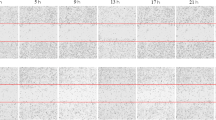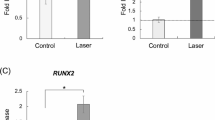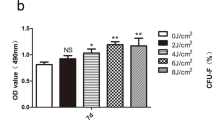Abstract
The application of Nd:YAG lasers in endodontics has been explored by many investigators for different purposes. The aim of this in vitro study is to evaluate the effects of Nd:YAG laser on osteoblast cell cultures. A 1,064 nm Nd:YAG laser was used to irradiate human osteoblast-like cells (Saos-2) in noncontact mode for 10 s with different energy settings. The settings varied were pulse energy (20–120 mJ), pulse repetition rate (10–30 Hz), and power output (0.2–3.6 W). He–Ne, the aiming beam of Nd:YAG laser, was used in noncontact mode for 10 s. After 7-, 14-, and 21-day incubation period, cell viability and proliferation were evaluated with methylthiazoletetrazolium (MTT) colorometric method. The comparison of average MTT values gave no statistically significant difference between 20 mJ, 10 Hz, He–Ne, and control (p<0.05). The differences between all other groups were significant (p<0.05). Increase in the pulse energy, pulse repetition rate, and power output has a negative effect on the cell viability and proliferation.
Similar content being viewed by others
Avoid common mistakes on your manuscript.
Introduction
Dental lasers have been used in dentistry in a wide range of applications including oral surgery [1], periodontics [2, 3], preventive dentistry [4, 5], and endodontics [6, 7] for more than 30 years.
One of the fundamentals of root canal therapy is the cleaning of root canals as thoroughly as possible to eliminate tissue debris and microorganisms. For this purpose, the application of lasers, especially Nd:YAG laser, has been explored by many investigators. It was found to be useful for the removal of the smear layer and debris [8], cleaning and shaping [9], bactericidal effect [10, 11], and apical seal after apicoectomy [7].
Although a number of studies have investigated the effects of Nd:YAG laser irradiation on dental hard tissues and microorganisms, there have been relatively few attempts to evaluate the effects of laser irradiation on surrounding tissues at the cellular level.
The aim of this in vitro study was to evaluate the effects of Nd:YAG laser irradiation at different energy settings on alveolar bone at cellular level by using Saos-2 osteoblast-like cell culture.
Materials and methods
Cell culture and morphological observations
Saos-2 human osteoblast-like cells (HTB-85, ATCC, USA) cultivated in T-25 flasks (Costar, Cambridge, USA) in Dulbecco’s modified eagle medium (DMEM) (Sigma, St Louis, MO, USA) supplemented with 10% v/v fetal bovine serum (Biochrom, Berlin, Germany) and 1% v/v antibiotic–antimycotic mixture. Cells were incubated at 37°C, 5% CO2, and 100% relative humidity and subcultured three times a week and were maintained at third passage. A mixture of 0.25% trypsin (Sigma, St Louis, MO, USA) and 0.02% EDTA (Sigma, St Louis, MO, USA) was used to detach the cells at logarithmic phase. The cells were plated at a concentration of 3×104 cell ml−1 in 96-well culture plates for cell vitality methylthiazoletetrazolium (MTT) assay (total of 360 wells were prepared as 24 wells for each group). The control and laser-treated cultures were tested at 7th, 14th, and 21st days to perform MTT assays. Morphological status was observed daily with an inverted microscope (Olympus CK 40, Japan) until the termination of the last test.
Laser irradiation
Laser irradiation was carried out from a distance of 2 mm with a Nd:YAG laser (1,064 nm) (Pulse master 600 IQ, American Dental Technologies, USA) and a He–Ne laser (the aiming beam of the Nd:YAG laser). The diameter of the fiber optic cable was 320 μm. Nd:YAG laser irradiation was adjusted to the cell cultures in 13 different energy settings (Table 1). No laser irradiation was done to control cultures. All cultures were irradiated for 10 s. The tip of the fiber was cut after each irradiation for preventing the energy output decreasing. To assess the temperature increase during the irradiation procedure, which was carried out in the same way as the irradiation of the cell cultures, the maximum temperature increase in 100 μl culture medium in 96-well cell culture plates (starting from a room temperature of 21°C) was recorded by means of a digital thermometer–thermocouple (Extech Instruments, Model EA10, USA). The mean, maximum and minimum value and standard deviations of the eight measurements per irradiation groups were calculated subsequently (Table 2).
Biochemical MTT assays
A standard colorometric assay MTT (3-(4,5-dimethylthiazol-2-yl)-2,5-diphenyltetrazolium bromide) was used to estimate cell viability and proliferation. The amount of yellow MTT reduced to blue formazan is measured spectrophotometrically. This reduction takes place only when mitochondrial reductase enzymes are active and thus conversion is directly related to the number of viable cells. The production of purple formazan in cells treated with an agent is measured relative to the production in control cells and a dose–response curve can be generated [12]. When the cell viability and proliferation is increased in a culture, the MTT absorbance values will increase relative to the control.
The Saos-2 cell suspension was prepared at a concentration of 3×104 cell ml−1 and dispensed into the 96-well cell culture plates (100 μl well−1). The multiwell plates were incubated for 24 h at 37°C in 5% CO2 and 100% humidity. After 24 h, cells were irradiated with either Nd:YAG laser in different energy settings or He–Ne laser. In control wells, no irradiation was carried out. Then, the cells were incubated for 7, 14, and 21 days at 37°C in 5% CO2 and 100% humidity. After the incubation periods, plates were assessed and photographed with an inverted microscope. After the removal of the medium, 100 μl well−1 fresh DMEM and 13 μl well−1 MTT were added and kept in dark environment at 37°C for 4 h. After MTT solution was removed, 100 μl well−1 of dimethylsulfoxide (DMSO) and 13 μl well−1 glycine buffer solution (pH 10.31) was added to dissolve the formazan crystals. The absorbance values at 570 nm is an indicator of MTT and they were measured with a UV–visible spectrophotometer (LPB Pharmacia, Bromma, Sweden) at 570 nm. MTT assays were repeated in three separate experiments.
Statistical analysis
The percentage alterations of MTT reduction with respect to the values found in control and laser irradiated cultures were calculated according to the formula: % alteration = [(value of absorbance of the tested laser irradiation − value of absorbance of the control) / (value of absorbance of the control)] ×100.
Results were analyzed statistically by ANOVA test complemented with Tukey’s test. The level of significance was 5% (p≤0.05).
Results
Morphological observations
Inverted microscope observations of osteoblast-like cells showed an attachment of cells to the surface of the culture wells after 3 days dating from the irradiation. After the first incubation period (day 7), all cultures (control and laser irradiated) formed a confluent monolayer except the 7th, 10th, 11th, 12th, and 13th groups (Figs. 1 and 2).
At the 14th day of culture in groups 1, 14, and 15 (control), the cell layer began to detach from the surface (Fig. 3) and after this incubation period, the detached cells died. At the third incubation period (day 21), we observed granular substances in cytoplasms of the cells.
Cell vitality and proliferation
Figure 4 shows the results concerning cell vitality and proliferation found in test cultures, expressed as percentage of alteration according to the control.
Stimulation of the MTT reduction was more significant in the first week (maximal levels were observed around day 7) for all test and control wells and absorbance values were decreased on day 14 and minimal absorbance values were observed at day 21. Table 3 shows the mean and standard deviations of the absorbance values of laser-irradiated and control groups at days 7, 14, and 21.
At each incubation period, stimulation of the MTT reduction of group 1 and group 14 was higher than the absorbance of control wells, while stimulation of the MTT reduction of other laser-irradiated groups was lower than the absorbance of the control.
When the comparison was made between incubation periods, the differences between all three periods were statistically significant (p<0.05).
The comparison of pulse energy levels (mJ) gave no statistically significant difference between group 1 and group 14 as well as group 1 and group 15 (control) (p>0.05). There was no statistically significant difference between the groups which were irradiated with 60 mJ pulse energy and group15 (control) (p>0.05). The differences between all other pulse energy levels were statistically significant (p<0.05).
When the comparisons were made between the pulse repetition rates (pps), there was no statistically significant difference between 10 pps and control, 15 and 30 pps, 20 and 30 pps (p>0.05). The differences between the remaining repetition rates were statistically significant (p<0.05).
Discussion
In this study, Saos-2 human osteoblast-like cell culture was used to assess the effects of laser irradiation on osteoblasts in vitro. Saos-2 human osteoblast-like cells are derived from osteosarcoma; they mineralize in culture and are well characterized with respect to expression of osteoblastic traits [13, 14]. In vitro experiments have the advantage of easily controlled experimental factors that are often a problem when performing experiments in vivo. In vitro methods are simple, reproducible, cost-effective, relevant, and suitable for the evaluation of basic biological properties [15].
The MTT assays is a colorometric method for quantifying viable cell numbers. In viable cells, the methyl-tetrazolium ring is transformed to formazan by mitochondrial dehydrogenase. Formazan has a blue color and can be measured with a spectrophotometer. The amount of formazan produced is directly proportional to total viable cell number. MTT assay reflects cell numbers at any stage in their growth cycle [12]. The advantages of this method are its simplicity, rapidity, and precision. In addition, it does not require radioisotopes [16].
Morphological assessment revealed a gradual proliferation of cells in the incubation medium at day 7 and a monolayer formation was observed both in experimental and control groups. After this incubation time, the cells began to detach from the surface and a gradual cell death was observed. Likewise, MTT absorbance averages of all irradiated and control cultures were at peak on day 7 and after this incubation period, these values began to decrease. Morphological and MTT absorbance data were parallel with each other and these are in agreement with Vrouwenvelder [17]. He had stated that “after confluence, it is often observed that the formed cell layer detaches spontaneously from the underlying (nonrelative) substrate and/or because after confluence, cells grew forming multilayers and cells attached to the bottom of the plate may begin to die due to the lack of nutrients and senescence”.
There are a number of studies in which the effects of different laser systems on cell cultures were assessed. Kreisler et al. [18] found that a 809-nm diode laser, from a distance of 9 mm, had a stimulation effect on human gingival fibroblasts. In another study, Kreisler et al. [19] used a diode laser from a distance of 0.5 mm on cell cultures and found that high power densities lead to decrease in cell numbers. In our study, we observed decreased MTT absorbance values when energy settings were increased. Although the temperature measurements were not included in this study, this negative effect might be attributed to the temperature rise caused by the increase of laser energy on culture wells. However, there may be some other effects related to the physical nature of laser energy and these must be evaluated in new studies.
The maximum MTT absorbance values were obtained in group 14 (He–Ne). In group 1 (20 mJ, 10 pps, 10 s), the average MTT absorbance values were also greater than group 15 (control). The MTT absorbance values of all other experimental groups were lower than control. The laser energy settings higher than 20 mJ, 10 pps (group 1) have inhibitory effects on MTT absorbance values.
For group 4 (120 mJ, 10 pps), group 6 (80 mJ, 15 pps), and group 8 (60 mJ, 20 pps) the output power was 1.2 W. When the comparison was made between these three groups, the highest MTT absorbance values were observed in group 8. This result concerns that increasing the pulse energy with a constant output power leads to more negative viability and proliferation effect on cell cultures than increasing the pulse repetition rate. This observation is also valid for group 7 (120 mJ, 15 pps) and group 11 (60 mJ, 30 pps) which had a constant output power (1.8 W) and group 10 (120 mJ, 20 pps) and group 12 (80 mJ, 30 pps) with output power of 2.4 W.
When the output power is increased by increasing the pulse energy or pulse repetition rate, a decrease in MTT average values were observed and this was valid for all of the three incubation periods.
In this in vitro study, the osteoblast cell cultures were irradiated with Nd:YAG or He–Ne laser from a 2-mm distance directly. But in in vivo conditions, when the laser irradiation is directed to the root canals, great part the beam would be absorbed by root canal wall dentine and the laser energy which would be transmitted to the periapical region would be lower than the instant beam. Then, we think that the effects in periapical region may be lower than the results which were obtained in this study. However, these results about the effects of laser irradiation will help the clinicians to understand the effects of Nd:YAG laser and its aiming beam at cellular level. On the other side, we will evaluate the amount of transmitted laser energy through the root canal wall dentine and amount of energy density produced at the periapical region, in further animal and clinical studies.
Conclusion
Within the limitations of this in vitro study, the following conclusions may be drawn:
-
He–Ne laser and 20 mJ, 10 Hz, 10 s Nd:YAG laser irradiation had a stimulatory effect on the cell viability and proliferation of human osteoblast-like cell culture.
-
Increase in the pulse energy, pulse repetition rate, and power output has an inhibitory effect on the cell viability and proliferation of human osteoblast-like cell culture.
-
It was also concluded that usage of the lowest parameters should be chosen if the pulse energy and power output was appropriate for the suggested therapy.
References
Yeh S, Jain K, Andreanas S (2005) Using a diode laser to uncover dental implants in second-stage surgery. Gen Dent 53:414–417
Cobb CM (2006) Lasers in periodontics: a review of the literature. J Periodontol 77:545–564
Noguchi T, Sanaoka A, Fukuda M, Suzuki S, Aoki T (2005) Combined effects of Nd:YAG laser irradiation with local antibiotic application into periodontal pockets. J Int Acad Periodontol 7:8–15
Rodrigues LK, Dos Santos MN, Featherstone JD (2006) In situ mineral loss inhibition by CO2 laser and fluoride. J Dent Res 85:617–621
Hossain M, Nakamura Y, Kimura Y, Yamada Y, Kawanaka T, Matsumoto K (2001) Effect of pulsed Nd:YAG laser irradiation on acid demineralization of enamel and dentin. J Clin Laser Med Surg 19:105–108
Liu JF (2006) Effect of Nd:YAG laser pulpotomy on human primary molars. J Endod 32:404–407
Stabholz A, Khayat A, Ravanshad SH, McCarthy DW, Neev J, Torabinejad M (1992) Effects of Nd:YAG laser on apical seal of teeth after apicoectomy and retrofill. J Endod 18:371–375
Arisu HD, Bala O, Alimzhanova G, Turkoz E (2004) Assessment of morphological changes and permeability of apical dentin surfaces induced by Nd:YAG laser irradiation through retrograde cavity surfaces. J Contemp Dent Pract 5:102–113
Levy G (1992) Cleaning and shaping the root canal with a Nd:YAG laser beam: a comparative study. J Endod 18:123–127
Guthnecht N, Moritz A, Conrads G, Sievert T, Lampert F (1996) Bactericidal effect of the Nd:YAG laser in in vitro root canals. J Clin Laser Med Surg 14:77–80
Bergamens L, Moisiadas P, Teughels W, Van Meerbeek B, Quirynen M, Lambrechts P (2006) Bactericidal effect of Nd:YAG laser irradiation on some endodontic pathogens ex vivo. Int Endod J 39:447–457
Mosmann T (1983) Rapid colorimetric assay for cellular growth and survival: application to proliferation and cytotoxicity assays. J Immunol Methods 65:55–63
Rodan SB, Imai Y, Thiede MA, Wesolowski G, Thompson D, bar-Shavit Z, Shull S, Mann K, Rodan GA (1987) Characterization of a human osteosarcoma cell line (Saos-2) with osteoblastic properties. Cancer Res 47:4961–4966
Murray E, Provvedini D, Curran D, Catherwood B, Sussman H, Manolagas S (1987) Characterization of human osteoblastic osteosarcoma cell line (SAOS-2) with high bone alkaline phosphatase activity. J Bone Miner Res 2:231–238
Tyas MJ (1977) A method for the in vitro toxicity testing of dental restorative materials. J Dent Res 56:1285–1290
Huang FM, Tai KW, Chou MY, Chang YC (2002) Cytotoxicity of resin-, zinc oxide- eugenol-, and calcium hydroxide-based root canal sealers on human periodontal ligament cells and permanent V79 cells. Int Endod J 35:153–159
Vrouwenvelder WC, Groot CG, de Groot K (1993) Histological and biochemical evaluation of osteoblasts cultured on bioactive glass, hydroxylapatite, titanium alloy and stainless steel. J Biomed Mater Res 27:465–475
Kreisler M, Christoffers AB, Al-Haj H, Willerhausen B, D’Hoedt B (2002) Low level 809 nm diode laser induced in vitro stimulation of the proliferation of human gingival fibroblasts. Lasers Surg Med 30:365–369
Kreisler M, Daublander M, Willerhausen-Zönnchen B, D’Hoedt B (2001) Effects of diode laser irradiation on the survival rate of gingival fibroblast cell cultures. Lasers Surg Med 28:445–450
Author information
Authors and Affiliations
Corresponding author
Rights and permissions
About this article
Cite this article
Arisu, H.D., Türköz, E. & Bala, O. Effects of Nd:Yag laser irradiation on osteoblast cell cultures. Lasers Med Sci 21, 175–180 (2006). https://doi.org/10.1007/s10103-006-0398-6
Received:
Revised:
Accepted:
Published:
Issue Date:
DOI: https://doi.org/10.1007/s10103-006-0398-6








